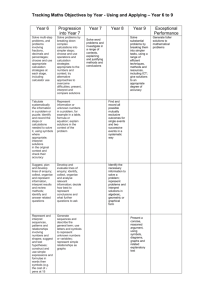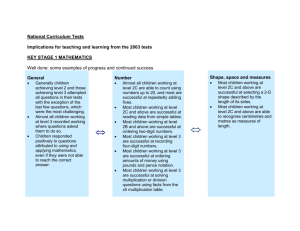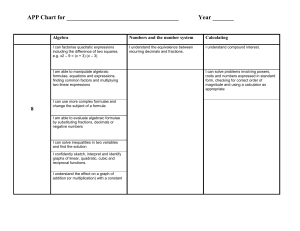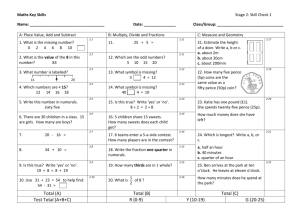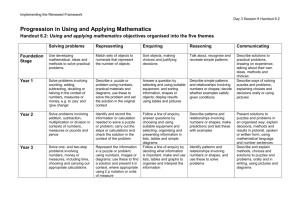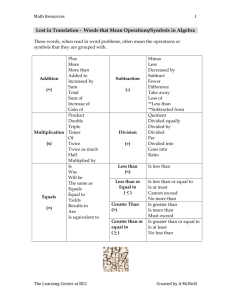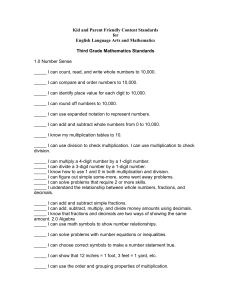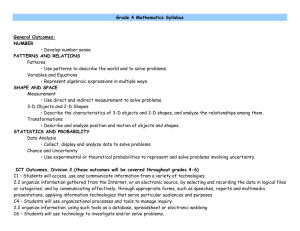Mathsworks Yearly Plans Year 6 Block B
advertisement
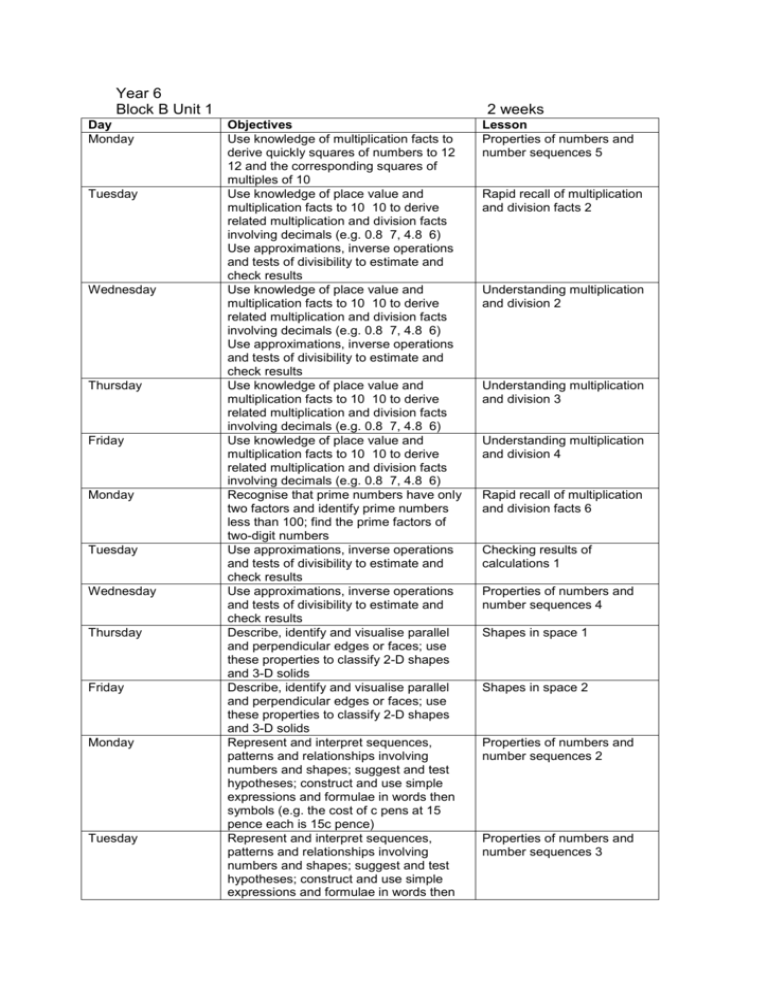
Year 6 Block B Unit 1 Day Monday Tuesday Wednesday Thursday Friday Monday Tuesday Wednesday Thursday Friday Monday Tuesday 2 weeks Objectives Use knowledge of multiplication facts to derive quickly squares of numbers to 12 12 and the corresponding squares of multiples of 10 Use knowledge of place value and multiplication facts to 10 10 to derive related multiplication and division facts involving decimals (e.g. 0.8 7, 4.8 6) Use approximations, inverse operations and tests of divisibility to estimate and check results Use knowledge of place value and multiplication facts to 10 10 to derive related multiplication and division facts involving decimals (e.g. 0.8 7, 4.8 6) Use approximations, inverse operations and tests of divisibility to estimate and check results Use knowledge of place value and multiplication facts to 10 10 to derive related multiplication and division facts involving decimals (e.g. 0.8 7, 4.8 6) Use knowledge of place value and multiplication facts to 10 10 to derive related multiplication and division facts involving decimals (e.g. 0.8 7, 4.8 6) Recognise that prime numbers have only two factors and identify prime numbers less than 100; find the prime factors of two-digit numbers Use approximations, inverse operations and tests of divisibility to estimate and check results Use approximations, inverse operations and tests of divisibility to estimate and check results Describe, identify and visualise parallel and perpendicular edges or faces; use these properties to classify 2-D shapes and 3-D solids Describe, identify and visualise parallel and perpendicular edges or faces; use these properties to classify 2-D shapes and 3-D solids Represent and interpret sequences, patterns and relationships involving numbers and shapes; suggest and test hypotheses; construct and use simple expressions and formulae in words then symbols (e.g. the cost of c pens at 15 pence each is 15c pence) Represent and interpret sequences, patterns and relationships involving numbers and shapes; suggest and test hypotheses; construct and use simple expressions and formulae in words then Lesson Properties of numbers and number sequences 5 Rapid recall of multiplication and division facts 2 Understanding multiplication and division 2 Understanding multiplication and division 3 Understanding multiplication and division 4 Rapid recall of multiplication and division facts 6 Checking results of calculations 1 Properties of numbers and number sequences 4 Shapes in space 1 Shapes in space 2 Properties of numbers and number sequences 2 Properties of numbers and number sequences 3 Wednesday Thursday Friday Block B Unit 2 Day Monday Tuesday Wednesday Thursday Friday symbols (e.g. the cost of c pens at 15 pence each is 15c pence) Make and draw shapes with increasing accuracy and apply knowledge of their properties Make and draw shapes with increasing accuracy and apply knowledge of their properties Assessment Symmetry, angles and position 2 Symmetry, angles and position 3 2 weeks Objectives Use knowledge of multiplication facts to derive quickly squares of numbers to 12 12 and the corresponding squares of multiples of 10 Use knowledge of place value and multiplication facts to 10 10 to derive related multiplication and division facts involving decimals (e.g. 0.8 7, 4.8 6) Use knowledge of place value and multiplication facts to 10 10 to derive related multiplication and division facts involving decimals (e.g. 0.8 7, 4.8 6) Tabulate systematically the information in a problem or puzzle; identify and record the steps or calculations needed to solve it, using symbols where appropriate; interpret solutions in the original context and check their accuracy Use knowledge of place value and multiplication facts to 10 10 to derive related multiplication and division facts involving decimals (e.g. 0.8 7, 4.8 6) Recognise that prime numbers have only two factors and identify prime numbers less than 100; find the prime factors of two-digit numbers Use approximations, inverse operations and tests of divisibility to estimate and check results Represent and interpret sequences, patterns and relationships involving numbers and shapes; suggest and test hypotheses; construct and use simple expressions and formulae in words then symbols (e.g. the cost of c pens at 15 pence each is 15c pence) Use knowledge of multiplication facts to derive quickly squares of numbers to 12 12 and the corresponding squares of multiples of 10 Use approximations, inverse operations and tests of divisibility to estimate and check results Represent and interpret sequences, patterns and relationships involving numbers and shapes; suggest and test Lesson Rapid recall of multiplication and division facts 4 Mental calculation strategies ( and ) 4 Mental calculation strategies ( and ) 5 Properties of numbers and number sequences 8 Checking results of calculations 2 Monday Tuesday Wednesday Thursday Friday Monday Tuesday hypotheses; construct and use simple expressions and formulae in words then symbols (e.g. the cost of c pens at 15 pence each is 15c pence) Use a calculator to solve problems involving multi-step calculations Represent and interpret sequences, patterns and relationships involving numbers and shapes; suggest and test hypotheses; construct and use simple expressions and formulae in words then symbols (e.g. the cost of c pens at 15 pence each is 15c pence) Use a calculator to solve problems involving multi-step calculations Represent and interpret sequences, patterns and relationships involving numbers and shapes; suggest and test hypotheses; construct and use simple expressions and formulae in words then symbols (e.g. the cost of c pens at 15 pence each is 15c pence) Use a calculator to solve problems involving multi-step calculations Describe, identify and visualise parallel and perpendicular edges or faces; use these properties to classify 2-D shapes and 3-D solids Make and draw shapes with increasing accuracy and apply knowledge of their properties Represent and interpret sequences, patterns and relationships involving numbers and shapes; suggest and test hypotheses; construct and use simple expressions and formulae in words then symbols (e.g. the cost of c pens at 15 pence each is 15c pence) Represent and interpret sequences, patterns and relationships involving numbers and shapes; suggest and test hypotheses; construct and use simple expressions and formulae in words then symbols (e.g. the cost of c pens at 15 pence each is 15c pence) Represent and interpret sequences, patterns and relationships involving numbers and shapes; suggest and test hypotheses; construct and use simple expressions and formulae in words then symbols (e.g. the cost of c pens at 15 pence each is 15c pence) Tabulate systematically the information in a problem or puzzle; identify and record the steps or calculations needed to solve it, using symbols where appropriate; interpret solutions in the original context and check their accuracy Represent and interpret sequences, patterns and relationships involving Using and applying 5 (N&C) Time 1 Time 2 Shapes in space 3 Using and applying 5 (SSM) Using and applying 8 (SSM) Using and applying 10 (N&C) Wednesday Thursday Friday numbers and shapes; suggest and test hypotheses; construct and use simple expressions and formulae in words then symbols (e.g. the cost of c pens at 15 pence each is 15c pence) Tabulate systematically the information in a problem or puzzle; identify and record the steps or calculations needed to solve it, using symbols where appropriate; interpret solutions in the original context and check their accuracy Represent and interpret sequences, patterns and relationships involving numbers and shapes; suggest and test hypotheses; construct and use simple expressions and formulae in words then symbols (e.g. the cost of c pens at 15 pence each is 15c pence) Tabulate systematically the information in a problem or puzzle; identify and record the steps or calculations needed to solve it, using symbols where appropriate; interpret solutions in the original context and check their accuracy Represent and interpret sequences, patterns and relationships involving numbers and shapes; suggest and test hypotheses; construct and use simple expressions and formulae in words then symbols (e.g. the cost of c pens at 15 pence each is 15c pence) Assessment Block B Unit 3 Day Monday Tuesday Wednesday Thursday Using and applying 16 (N&C) Using and applying 18 (N&C) 2 weeks Objectives Use knowledge of multiplication facts to derive quickly squares of numbers to 12 12 and the corresponding squares of multiples of 10 Use knowledge of place value and multiplication facts to 10 10 to derive related multiplication and division facts involving decimals (e.g. 0.8 7, 4.8 6) Use knowledge of place value and multiplication facts to 10 10 to derive related multiplication and division facts involving decimals (e.g. 0.8 7, 4.8 6) Use approximations, inverse operations and tests of divisibility to estimate and check results Use knowledge of place value and multiplication facts to 10 10 to derive related multiplication and division facts involving decimals (e.g. 0.8 7, 4.8 6) Recognise that prime numbers have only two factors and identify prime numbers less than 100; find the prime factors of two-digit numbers Lesson Properties of numbers and number sequences 6 Understanding multiplication and division 7 Mental calculation strategies ( and ) 6 Properties of numbers and number sequences 7 Friday Monday Tuesday Wednesday Thursday Friday Represent and interpret sequences, patterns and relationships involving numbers and shapes; suggest and test hypotheses; construct and use simple expressions and formulae in words then symbols (e.g. the cost of c pens at 15 pence each is 15c pence) Recognise that prime numbers have only two factors and identify prime numbers less than 100; find the prime factors of two-digit numbers Use approximations, inverse operations and tests of divisibility to estimate and check results Represent and interpret sequences, patterns and relationships involving numbers and shapes; suggest and test hypotheses; construct and use simple expressions and formulae in words then symbols (e.g. the cost of c pens at 15 pence each is 15c pence) Use knowledge of multiplication facts to derive quickly squares of numbers to 12 12 and the corresponding squares of multiples of 10 Use a calculator to solve problems involving multi-step calculations Represent and interpret sequences, patterns and relationships involving numbers and shapes; suggest and test hypotheses; construct and use simple expressions and formulae in words then symbols (e.g. the cost of c pens at 15 pence each is 15c pence) Tabulate systematically the information in a problem or puzzle; identify and record the steps or calculations needed to solve it, using symbols where appropriate; interpret solutions in the original context and check their accuracy Use a calculator to solve problems involving multi-step calculations Use a calculator to solve problems involving multi-step calculations Use a calculator to solve problems involving multi-step calculations Represent and interpret sequences, patterns and relationships involving numbers and shapes; suggest and test hypotheses; construct and use simple expressions and formulae in words then symbols (e.g. the cost of c pens at 15 pence each is 15c pence) Describe, identify and visualise parallel and perpendicular edges or faces; use these properties to classify 2-D shapes and 3-D solids Make and draw shapes with increasing accuracy and apply knowledge of their properties Properties of numbers and number sequences 9 Using and applying 11 (N&C) Time 3 Time 4 Using and applying 1 (SSM) Shapes in space 4 Monday Tuesday Wednesday Thursday Friday Represent and interpret sequences, patterns and relationships involving numbers and shapes; suggest and test hypotheses; construct and use simple expressions and formulae in words then symbols (e.g. the cost of c pens at 15 pence each is 15c pence) Make and draw shapes with increasing accuracy and apply knowledge of their properties Represent and interpret sequences, patterns and relationships involving numbers and shapes; suggest and test hypotheses; construct and use simple expressions and formulae in words then symbols (e.g. the cost of c pens at 15 pence each is 15c pence) Tabulate systematically the information in a problem or puzzle; identify and record the steps or calculations needed to solve it, using symbols where appropriate; interpret solutions in the original context and check their accuracy Represent and interpret sequences, patterns and relationships involving numbers and shapes; suggest and test hypotheses; construct and use simple expressions and formulae in words then symbols (e.g. the cost of c pens at 15 pence each is 15c pence) Tabulate systematically the information in a problem or puzzle; identify and record the steps or calculations needed to solve it, using symbols where appropriate; interpret solutions in the original context and check their accuracy Represent and interpret sequences, patterns and relationships involving numbers and shapes; suggest and test hypotheses; construct and use simple expressions and formulae in words then symbols (e.g. the cost of c pens at 15 pence each is 15c pence) Tabulate systematically the information in a problem or puzzle; identify and record the steps or calculations needed to solve it, using symbols where appropriate; interpret solutions in the original context and check their accuracy Represent and interpret sequences, patterns and relationships involving numbers and shapes; suggest and test hypotheses; construct and use simple expressions and formulae in words then symbols (e.g. the cost of c pens at 15 pence each is 15c pence) Assessment Symmetry, angles and position 4 Using and applying 2 (SSM) Using and applying 3 (SSM) Using and applying 7 (SSM)
